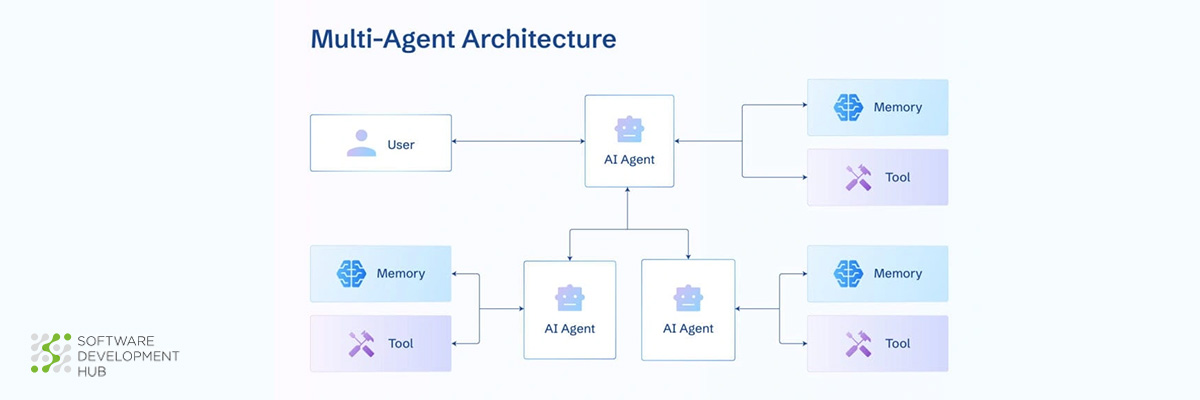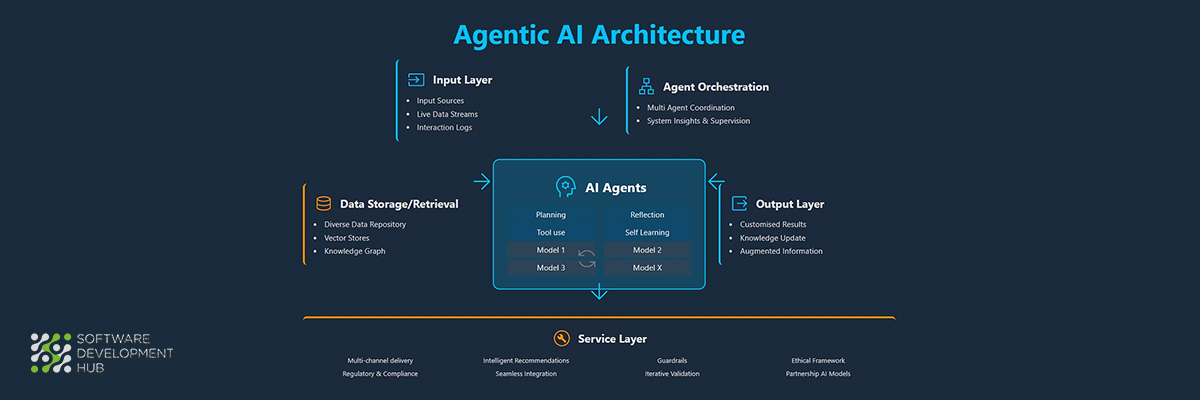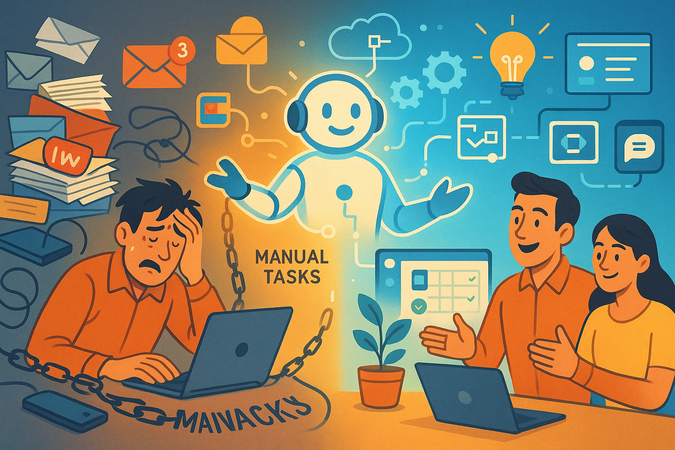Agentic AI Explained: AI That Acts On Its Own
Agentic AI refers to artificial intelligence systems that operate with minimal human supervision, making autonomous decisions and executing complex tasks to achieve specific objectives. Recent industry projections indicate that AI could automate up to 30% of work hours by 2030, enabling developers to focus on more sophisticated challenges and innovation. The technology represents a notable departure from conventional AI approaches—these systems actively plan and execute rather than simply respond to direct commands.
Traditional robotic process automation (RPA) systems operate within rigid parameters, handling rule-based tasks with predetermined logic. Agentic AI systems, however, adapt their responses based on incoming data and apply multi-step reasoning to solve complex problems. The distinguishing characteristic lies in their goal-oriented planning capabilities—rather than waiting for explicit instructions, these systems analyze objectives and determine the required sequence of actions independently. Current adoption patterns show promise, with over half of service professionals reporting significant improvements in customer interactions, including faster response times and higher satisfaction rates.
What should you know about implementing agentic AI systems in your organization? This article examines the core mechanisms behind autonomous AI decision-making, practical applications across different industries, and implementation strategies for your specific projects. Understanding these systems becomes increasingly important as businesses evaluate automation technologies that can operate with greater independence than traditional software solutions.
What is Agentic AI?
Agentic AI definition and meaning
Agentic AI systems operate through a fundamentally different paradigm than conventional artificial intelligence applications. The term "agentic" describes systems with agency—the capacity to act independently toward specific objectives with minimal human oversight. These systems actively perceive environmental data, apply reasoning frameworks, execute strategic actions, and incorporate learning from operational outcomes.
The architectural foundation combines machine learning algorithms, reinforcement learning protocols, natural language processing (NLP) capabilities, and large language models (LLMs) to enable multi-step reasoning processes. Four core components enable this functionality: event triggers that initiate system responses, cognitive control mechanisms for goal interpretation and strategy formation, execution modules for task completion, and memory architectures for experience-based learning.
Consider a high-level business request: "Organize a one-day offsite for my team next month." An agentic system processes this objective independently, checking calendar availability, researching suitable venues, coordinating facility bookings, and drafting preliminary agendas. The system designs its own workflow and selects appropriate tools to accomplish these interconnected tasks without requiring step-by-step human guidance.
How it differs from traditional AI and chatbots
Traditional AI systems operate within clearly defined parameters, following explicit programming rules or training data without autonomous decision-making capabilities beyond their original configuration. Agentic AI demonstrates autonomy, goal-driven behavior patterns, and adaptive responses to changing conditions. The distinction resembles comparing a calculator with a financial advisor who not only performs calculations but proactively analyzes patterns and recommends investment strategies.
Conventional chatbots and virtual assistants like Siri or Alexa exhibit specific operational characteristics:
- Reactive responses triggered by user input
- Rigid conversation flows with limited flexibility
- Command execution based on predetermined programming
- Performance improvements requiring manual retraining
Agentic systems operate with different capabilities:
- Proactive operation without waiting for specific commands
- Dynamic workflow planning with real-time adjustments
- Strategic decision-making considering broader operational contexts
- Continuous self-improvement through learning algorithms
The proactivity factor represents a crucial distinction—while chatbots respond to user inquiries, agentic AI anticipates requirements and initiates actions to address potential issues before they escalate. These systems don't simply assist; they initiate, coordinate, and execute complex task sequences autonomously.
Why it matters now
Current market conditions create specific demands that traditional automation cannot address effectively. Agentic AI tackles increasingly complex operational challenges that require adaptive reasoning rather than rule-based responses. Industry research provides compelling evidence of this technology's growing importance.
Gartner forecasts indicate that by 2028, 33% of enterprise software applications will incorporate agentic AI functionality, representing growth from less than 1% in 2024. This adoption will enable autonomous decision-making for 15% of daily work activities. Healthcare, finance, and manufacturing sectors show particular promise, with projections suggesting that by 2029, agentic AI will autonomously resolve 80% of common customer service interactions, reducing operational costs by 30%.
Organizations implementing these systems report measurable improvements. Early adopters document 20-30% faster workflow cycles, significant back-office cost reductions, and improved customer metrics—including 40% reductions in claim handling time and 15-point increases in net promoter scores.
Business leadership recognizes this potential. Over 25% of business leaders indicate their organizations are actively exploring agentic AI implementation. A KPMG survey of 100 large enterprise executives reveals that 12% of companies currently deploy AI agents, while Forrester Research notes that 90% of businesses expect agentic AI to affect their competitive positioning within five years.
We should acknowledge that agentic AI represents more than incremental automation improvements—it fundamentally alters human-AI collaboration models. OpenAI CEO Sam Altman emphasized this transformation at the 2024 World Economic Forum: "Let society and the technology co-evolve, and sort of step-by-step with a very tight feedback loop and course correction, [to] build these systems that deliver tremendous value while meeting safety requirements".
How Agentic AI Works
Agentic AI systems operate through a cognitive cycle that follows a continuous perceive-reason-act-learn pattern. This cyclical approach enables autonomous operation in dynamic environments, where systems make decisions and execute tasks without requiring step-by-step human guidance.
1. Perceive: Gathering and processing data
The perception component functions as the system's interface with external environments, converting raw inputs into structured data that supports reasoning processes. Data collection occurs across multiple input channels simultaneously:
- Text input from user commands, documents, or dialog
- Audio input including spoken instructions or environmental sounds
- Sensor data capturing real-world signals like motion, visual feeds, or GPS coordinates
During this phase, the system processes multimodal information, identifying meaningful patterns within unstructured data streams. The result is a structured understanding of current conditions, providing the contextual foundation for subsequent decision-making processes.
2. Reason: Using LLMs for decision-making
The reasoning module serves as the cognitive engine of the agent. Large language models function as orchestration systems, analyzing perceived data to interpret complex situations. This component performs several critical functions:
- Evaluates context and formulates intent
- Maintains dialog state, task context, and episodic history
- Accesses knowledge bases containing symbolic rules, ontologies, or learned models
- Defines desired outcomes and constructs action strategies
The reasoning process follows a think-act-observe loop for systematic problem-solving. Complex objectives are decomposed into manageable subtasks, allowing the system to approach problems through methodical analysis.
3. Act: Executing tasks via tools and APIs
The action module connects decision-making with execution by interfacing with digital or physical environments. Implementation includes:
- API integrations for accessing external systems and data
- Tool connections for search, summarization, calculations, and document handling
- Software-based execution for invoking commands and updating systems
These executed actions generate observable outcomes in the environment, which feed back into the perception phase—completing the operational cycle.
4. Learn: Improving through feedback loops
The learning capability differentiates agentic systems from conventional AI implementations. Through continuous feedback mechanisms, these systems:
- Evaluate success versus failure of executed actions
- Adjust strategies dynamically based on observed outcomes
- Store learnings for application to future similar tasks
- Minimize repeated errors through systematic adjustments
This process creates a "data flywheel" where each interaction improves future performance. The system develops increased efficiency and intelligence over time, adapting to evolving business requirements and changing operational demands.
Core Characteristics of Agentic AI Systems

Several distinctive characteristics separate agentic AI from conventional automation systems. These features enable autonomous operation, complex problem-solving, and continuous improvement through experience.
Goal-oriented planning
Agentic AI systems excel at transforming high-level objectives into actionable strategies without requiring detailed instructions. Unlike traditional systems that execute predetermined sequences, these systems analyze objectives and construct their own pathways to success. The process involves task decomposition, where complex goals are systematically broken down into manageable components.
Consider a supply chain optimization scenario: an agentic system independently identifies the necessary steps—demand forecasting, risk assessment, and dynamic transport planning. Rather than following a script, the system focuses on achieving the desired outcome through purpose-driven decision-making.
Multi-step reasoning and execution
The capacity for autonomous workflow management distinguishes agentic systems from sequential automation tools. These systems employ continuous "think-act-observe" loops that mirror human problem-solving approaches. Instead of processing tasks one after another, agentic AI coordinates multiple activities simultaneously, reducing overall cycle time.
A practical example appears in credit memo processing, where agents:
- Extract relevant data from multiple sources
- Draft document sections based on extracted information
- Generate confidence scores for accuracy validation
- Suggest follow-up questions for additional clarity
This parallel processing capability creates more responsive and efficient organizational workflows.
Autonomous decision-making
Decision independence represents the core strength of agentic systems. These systems evaluate multiple options, predict potential outcomes, and select optimal actions with minimal human oversight. The technology adapts continuously by processing new information and adjusting workflows in real-time—resequencing tasks, reprioritizing activities, or identifying anomalies before they create larger problems.
This autonomy makes workflows both faster and more intelligent, particularly valuable in environments where conditions change frequently.
Tool and memory integration
Agentic systems achieve versatility through seamless integration with external resources and sophisticated context retention. They connect with APIs, databases, search functions, and computational tools to extend capabilities beyond basic language processing. Equally important is their advanced memory architecture, which enables proactive, context-aware intelligence.
The memory system operates across multiple dimensions:
- Episodic memory: Specific events and interactions
- Procedural memory: Action sequences and workflows
- Semantic memory: Factual knowledge and domain expertise
This memory integration allows systems to build expertise over time and provide increasingly relevant recommendations. The result is an AI that learns from each interaction and applies that knowledge to future situations.
Practical Applications Across Industries
Organizations across different sectors now implement agentic AI systems to address specific operational challenges and improve business efficiency. The following examples demonstrate how autonomous AI delivers measurable results in key areas.
Customer Service Operations
Customer support functions experience significant changes through agentic AI implementation. Industry projections indicate that by 2028, approximately 68% of customer service interactions with technology vendors will utilize agentic systems. These systems search company documentation to provide accurate responses and deliver real-time updates on order status using shipping data and weather pattern analysis.
Implementation results show concrete improvements—one major shipping company reduced weekly onboarding paperwork processing from four hours to 30 minutes. Research indicates that 93% of business leaders expect these systems to enable more personalized and predictive customer experiences.
Marketing and Content Operations
Marketing departments adopt agentic AI for data analysis and content generation tasks. Teams use these systems to develop campaign briefs through natural language processing, with agents handling email content creation, customer segment development, and campaign performance analysis.
During customer engagement processes, AI agents analyze conversation context and qualify leads using specific criteria including purchase intent and budget parameters. The systems operate continuously, ensuring prospect engagement occurs around the clock.
Software Development Processes
Development teams report substantial efficiency improvements when using agentic AI. Complex tasks such as updating extensive Java codebases now complete in hours rather than weeks. This allows developers to concentrate on problem-solving and innovation instead of routine coding tasks.
Debugging processes evolve from traditional code examination to agent behavior analysis through specialized tools that track reasoning paths and visualize goal decomposition.
Healthcare Data Management
Healthcare providers manage unprecedented data volumes—projections show healthcare will generate over one-third of the expected 180 zettabytes of global data by 2025. However, only 3% of this information receives effective utilization.
Agentic systems coordinate case management across departments, streamline discharge procedures, and process insurance verification. This support proves essential in healthcare, where medical knowledge doubles every 73 days.
Security and Monitoring Systems
Security operations shift from passive monitoring to active response capabilities through agentic AI. Systems detect perimeter breaches, issue immediate voice warnings through IP communications, notify relevant personnel, and provide status updates.
Beyond security applications, these systems monitor elderly patients for falls, identify distress indicators in ICUs, verify PPE compliance in medical facilities, and detect equipment deterioration before failures occur. All actions generate automatic logs with video, audio, and timestamp documentation.
Read also: Healthcare Apps: Development Cost & Features
Implementation Approaches for Agentic AI Systems
 Building agentic AI systems requires careful consideration of available frameworks, technical requirements, and implementation strategies. Organizations have several viable approaches depending on their technical capabilities and business objectives.
Building agentic AI systems requires careful consideration of available frameworks, technical requirements, and implementation strategies. Organizations have several viable approaches depending on their technical capabilities and business objectives.
Framework-Based Development with NVIDIA Blueprints
NVIDIA Blueprints offer pre-configured reference workflows designed specifically for agentic AI applications. Developers can deploy these blueprints as NVIDIA Launchables—preconfigured environments that eliminate manual setup requirements. The platform provides industry-specific templates covering healthcare agents, network configuration planning, and video search capabilities.
These blueprints address a common challenge in AI development: the complexity of integrating multiple components into cohesive systems. Rather than building from scratch, development teams can adapt proven architectures to their specific use cases.
Low-Code Implementation Options
For organizations seeking faster deployment, n8n provides a visual approach to building agent-based workflows. The platform enables construction of specialized AI agent teams that collaborate within visual workflows. N8n supports LangChain nodes, facilitating connections to various LLMs and vector databases while maintaining integration capabilities with over 500 applications.
Zapier offers extensive pre-built integrations—over 6,000 connections—but focuses primarily on trigger-based automation rather than the complex reasoning capabilities required for true agentic behavior. This distinction matters when evaluating platforms for autonomous decision-making applications.
LLM Selection Criteria
The large language model functions as the central decision engine, interpreting inputs, reasoning through context, executing tool calls, and communicating results. Key selection factors include:
- Reasoning capabilities and function-calling performance
- Context window length for complex task handling
- Deployment requirements (cloud-based vs. on-premises)
- Integration compatibility with existing systems
- Cost considerations for expected usage volumes
Design Principles for Autonomous Operation
Successful agentic systems prioritize simplicity in initial implementations, adding complexity only when business requirements justify increased sophistication. These systems typically begin with either direct commands or interactive user discussions, then operate independently while continuously gathering environmental feedback.
Implementing appropriate guardrails remains crucial for production deployments. Organizations should establish human-in-the-loop approval processes for critical decisions and define clear behavioral boundaries before agents interact with business-critical systems. This approach balances operational efficiency with risk management requirements.
The development process should account for iterative improvement, as these systems learn and adapt based on operational experience. We recommend starting with well-defined use cases before expanding to more complex scenarios.
Conclusion
Agentic AI systems represent a notable evolution in artificial intelligence capabilities, moving from reactive automation to autonomous agents that can plan, execute, and adapt independently. These systems demonstrate their value through four core capabilities: environmental perception, multi-step reasoning, autonomous execution, and continuous learning from feedback loops. The distinction lies in their ability to operate proactively rather than waiting for explicit instructions.
Current adoption data shows practical business impact. Organizations implementing agentic AI systems report 20-30% faster workflow cycles and measurable cost reductions across multiple sectors. The technology addresses operational challenges in customer service, software development, healthcare management, and security applications through autonomous decision-making capabilities.
The operational advantage of agentic systems stems from their capacity to handle unpredictable scenarios through reasoning rather than following predetermined scripts. Continuous feedback loops enable these systems to improve performance with each interaction, creating what industry analysts describe as a data-driven improvement cycle.
Implementation options continue to expand through frameworks like NVIDIA Blueprints and visual workflow platforms, though organizations should carefully evaluate LLM selection and implement appropriate control mechanisms. We recommend starting with specific use cases that can demonstrate measurable value before scaling to broader applications.
Looking ahead, the business case for agentic AI will likely strengthen as system costs decrease and capabilities expand. Companies that begin exploring these technologies now can better understand their potential applications and develop the expertise needed for successful implementation. The shift from traditional automation to autonomous systems requires careful planning, but early adopters may find significant competitive advantages in operational efficiency and response capabilities.
Categories
About the author
Share
Need a project estimate?
Drop us a line, and we provide you with a qualified consultation.







